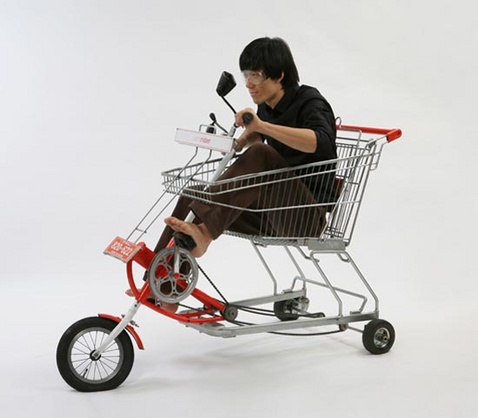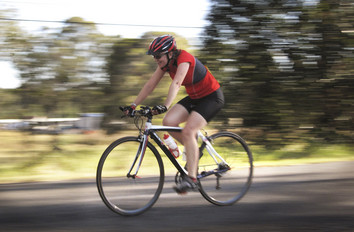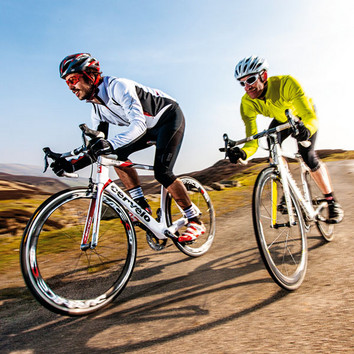Some time ago my partner was looking for a bike to commute and do some general road riding on. Even though I was working in a bike shop at the time, she decided to look around herself and get a second and third opinion. I didn't take it personally.
After visiting a few local shops she came home confused about the difference between flat bar and road bikes.
With this in mind I would like to provide some pointers about each bike and the benefits and drawbacks of each. I have thrown in the "hybrid" as well because it can be a very good commuting bike for some people.
Firstly, one of the most important distinctions when comparing these bikes is rider position. When set up neutrally, a quick look at each bike in profile can explain this easily:
Hybrid: the saddle will quite obviously be positioned below the level of the handlebars.
Flat Bar road bike: the saddle will be approximately level with the handlebars.
Road bike: the saddle will be level or above the handlebar level and then it becomes a measurement of how far this distance is.
Note also the difference in distance from the saddle tip to the handle bar: A road bike has a shorter top tube length, but with the forward projecting nature of drop bars ends up in quite a stretched out position.
This is just a general way of creating a picture in your mind of position. If you imagine your body on each of these bikes in turn you can get a clear understanding of each bikes purpose; from the relaxed upright posture of many hybrids, to the racing orientated, head down bum up position on a road bike.
Hybrid:

It's a hybrid, but not really what I had in mind.
The hybrid, as the name suggests, is a blend of mountain bike and road bike. In practice, the only thing really in common with a road bike is the wheel diameter, and the fact that while they share many mountain bike components they are truly only to be ridden on sealed surfaces, not off-road.
Although the wheels have the same diameter as a road bike, the tires are a lot wider. A road bike tire is typically 700x23 (700 is the diameter, 23 the width in millimetres), whereas a hybrid tire usually starts at 700x32, so substantially wider and obviously quite a bit slower, yet more rubber equates to greater comfort when riding.
Many hybrids' display obvious mountain bike similarities. Disc brakes and suspension forks are immediately recognisable, yet these parts are designed more for use on the road than on the trails. Disc brakes work in all weather and the suspension irons out potholes and vibration resulting in greater control.
Gearing is set up quite low in comparison with a road bike, making it a lot easier to peddle up inclines.
The hybrid is for the more relaxed, casual rider. As they are "compact" frames they are measured by the seat tube height, crank to clamp. A long wheelbase and "easy" angles results in stability and confidence when riding.
For longer rides, stay clear of the "comfort hybrid". This style is too relaxed for most commuting and serious riding applications. On the other hand the "sport hybrid" is an ideal everyday bike for long or short rides. They are comfortable, can handle all weather and surface conditions and generally roll smoothly and efficiently.
Flat Bar Road:
 The flat bar road bike is kind of what the name suggests: a road bike with flat handlebars not drops. But this is only part of the story.
The flat bar road bike is kind of what the name suggests: a road bike with flat handlebars not drops. But this is only part of the story.
Riding position is partially dictated by the nature of the flat handlebars; unless you attach bar ends, you are limited to one hand position only.
V-brakes can be found as they can cope with wider tire widths and also trigger gear shifters, as they are designed to be mounted onto flat handlebars - although the gearing will be higher than on a standard bike as the 700x25-28mm tires create very little rolling resistance.
Forks are rigid (like a road bike) as the bike is designed more for efficiency and speed than comfort.
The flat bar is the perfect touring or commuting bike. It is very common to find attachment points on these bikes for panniers and the strong frame materials like alloy and steel allow a large amount of weight to be carried.
A flat bar can be ridden comfortably for long distances all day if you're that way inclined.
Road:
Road bikes were created with one thing in mind: race really fast! These bikes are the pinnacle of efficiency, aerodynamics and speed. Every component is designed with high performance and weight saving in mind.
The road bike will have steep angled forks and very short chainstays (the frame tube running behind the bottom bracket to the rear axle), creating the shortest wheelbase of any of these bikes. As a result, the steering is very snappy, yet in practice little input is required to change direction when riding; it is more a matter of leaning into a corner as opposed to turning the bars.
 One thing I noticed when I first got on a road bike was that when turning tightly the front wheel hit my foot when the pedal was at 3 o'clock. I thought something was wrong with the bike! (they all laughed at the mountain biker attempting to be a roadie). These are probably not the best choice for riding and manoeuvering where constant sharp turning is required. It is doable but not ideal.
One thing I noticed when I first got on a road bike was that when turning tightly the front wheel hit my foot when the pedal was at 3 o'clock. I thought something was wrong with the bike! (they all laughed at the mountain biker attempting to be a roadie). These are probably not the best choice for riding and manoeuvering where constant sharp turning is required. It is doable but not ideal.
The drop bars are designed to get you low down out of the wind when racing, and to reduce the advantage you may give a drafting rider. I like them for descending and can get good leverage on the brakes when in the "drop" position. This style of bar is also good for finding alternative hand positions when the wrists get sore and uncomfortable on long rides.
This is probably the most important bike to get fitted to professionally. Because of the more extreme body position, and the fact that most saddle hours take place on a road bike, incorrect fitting can lead to a lot of discomfort and even injury. These are the best bikes for a big day out, as long as you are comfortable.
If you plan on racing, or regularly plug high mileage weeks, the road bike is the way to go.
The hardest thing to know when first purchasing a bike is what riding will I be doing and how often? I want to commute through the city, but I also want to meet up with the Saturday bunch and perhaps even race in the future...
These can be difficult questions to answer. Before going to the bike shop carry a picture in your mind of your intention for riding a bike, as it makes the decision so much easier.


